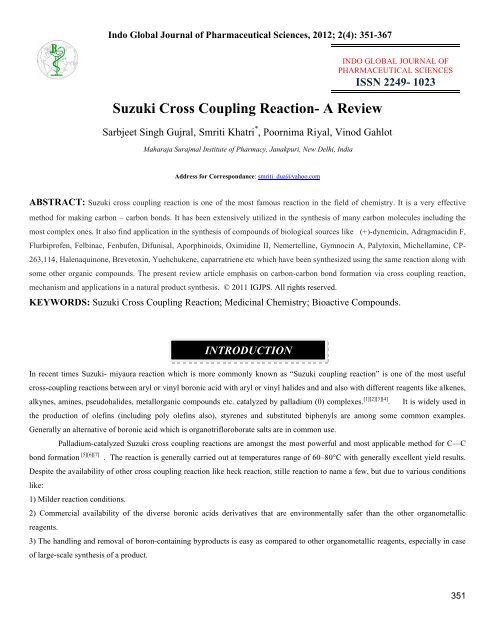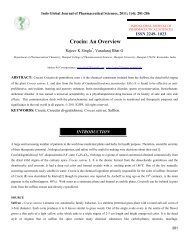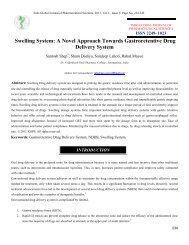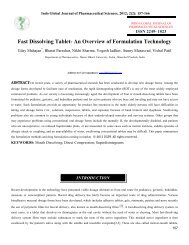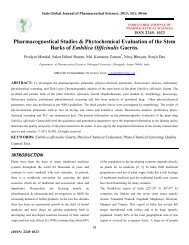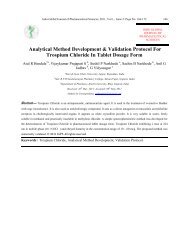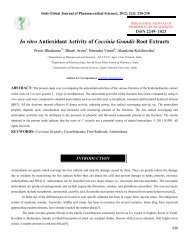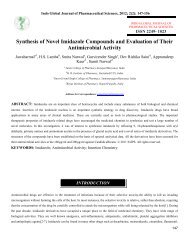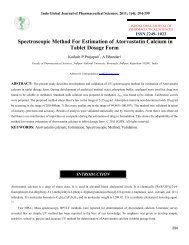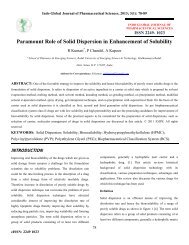Suzuki Cross Coupling Reaction- A Review - Indo Global Journal of ...
Suzuki Cross Coupling Reaction- A Review - Indo Global Journal of ...
Suzuki Cross Coupling Reaction- A Review - Indo Global Journal of ...
Create successful ePaper yourself
Turn your PDF publications into a flip-book with our unique Google optimized e-Paper software.
<strong>Indo</strong> <strong>Global</strong> <strong>Journal</strong> <strong>of</strong> Pharmaceutical Sciences, 2012; 2(4): 351-367<strong>Suzuki</strong> <strong>Cross</strong> <strong>Coupling</strong> <strong>Reaction</strong>- A <strong>Review</strong>Sarbjeet Singh Gujral, Smriti Khatri * , Poornima Riyal, Vinod GahlotMaharaja Surajmal Institute <strong>of</strong> Pharmacy, Janakpuri, New Delhi, IndiaINDO GLOBAL JOURNAL OFPHARMACEUTICAL SCIENCESISSN 2249- 1023Address for Correspondance: smriti_dua@yahoo.comABSTRACT: <strong>Suzuki</strong> cross coupling reaction is one <strong>of</strong> the most famous reaction in the field <strong>of</strong> chemistry. It is a very effectivemethod for making carbon – carbon bonds. It has been extensively utilized in the synthesis <strong>of</strong> many carbon molecules including themost complex ones. It also find application in the synthesis <strong>of</strong> compounds <strong>of</strong> biological sources like (+)-dynemicin, Adragmacidin F,Flurbipr<strong>of</strong>en, Felbinac, Fenbufen, Difunisal, Aporphinoids, Oximidine II, Nemertelline, Gymnocin A, Palytoxin, Michellamine, CP-263,114, Halenaquinone, Brevetoxin, Yuehchukene, caparratriene etc which have been synthesized using the same reaction along withsome other organic compounds. The present review article emphasis on carbon-carbon bond formation via cross coupling reaction,mechanism and applications in a natural product synthesis. © 2011 IGJPS. All rights reserved.KEYWORDS: <strong>Suzuki</strong> <strong>Cross</strong> <strong>Coupling</strong> <strong>Reaction</strong>; Medicinal Chemistry; Bioactive Compounds.INTRODUCTIONIn recent times <strong>Suzuki</strong>- miyaura reaction which is more commonly known as “<strong>Suzuki</strong> coupling reaction” is one <strong>of</strong> the most usefulcross-coupling reactions between aryl or vinyl boronic acid with aryl or vinyl halides and and also with different reagents like alkenes,alkynes, amines, pseudohalides, metallorganic compounds etc. catalyzed by palladium (0) complexes. [1][2][3][4] . It is widely used inthe production <strong>of</strong> olefins (including poly olefins also), styrenes and substituted biphenyls are among some common examples.Generally an alternative <strong>of</strong> boronic acid which is organotrifloroborate salts are in common use.Palladium-catalyzed <strong>Suzuki</strong> cross coupling reactions are amongst the most powerful and most applicable method for C—Cbond formation [5][6][7] . The reaction is generally carried out at temperatures range <strong>of</strong> 60–80°C with generally excellent yield results.Despite the availability <strong>of</strong> other cross coupling reaction like heck reaction, stille reaction to name a few, but due to various conditionslike:1) Milder reaction conditions.2) Commercial availability <strong>of</strong> the diverse boronic acids derivatives that are environmentally safer than the other organometallicreagents.3) The handling and removal <strong>of</strong> boron-containing byproducts is easy as compared to other organometallic reagents, especially in case<strong>of</strong> large-scale synthesis <strong>of</strong> a product.351
<strong>Indo</strong> <strong>Global</strong> <strong>Journal</strong> <strong>of</strong> Pharmaceutical Sciences, 2012; 2(4): 351-367So we can say that <strong>Suzuki</strong> cross coupling reaction has an edge over the other cross coupling reactions as this reaction is not onlyrestricted to simple compounds but is frequently used in the production <strong>of</strong> complex compounds also. [8].An example <strong>of</strong> suzuki reactionRole <strong>of</strong> Transition metals in organic chemistryIn the late 20th century when extensive work on development <strong>of</strong> newer way <strong>of</strong> producing organic compounds was gaining interestamong chemists, transition metals became the first choice <strong>of</strong> the chemists in organic chemistry synthesis which led to the development<strong>of</strong> a large number <strong>of</strong> transition metal-catalyzed reactions for the same. Transition metals can activate various organic compounds andthrough this activation they can catalyze the formation <strong>of</strong> new bonds. Palladium was the first known transition metal which was usedin organic synthesis which can induce the formation <strong>of</strong> carbon- carbon bond on the account that ethylene was oxidized toacetaldehyde by air in a palladium-catalyzed reaction and this became the industrially important Wacker process [9] . Subsequentresearch on palladium-catalyzed carbonylation led to newer reactions for the formation <strong>of</strong> carbon-carbon bonds.Palladium-catalyzed carbon-carbon bond formation via cross couplingThe principle mechanism <strong>of</strong> palladium-catalyzed cross couplings is that two molecules are adsorbed on the metal via the formation <strong>of</strong>metal-carbon bonds( an example <strong>of</strong> Heterogenous catalysis) . In this way the carbon atoms bound to palladium are brought very closeto one another. In the next step they couple to one another and this leads to the formation <strong>of</strong> a new carbon-carbon single bond. Thereare two types <strong>of</strong> cross-coupling reactions according to this principle that have become important in organic synthesis. These two types<strong>of</strong> reactions are as follows:RX + R’Pd (0)R’Relectrophilic partner nucleophilic partnerRX + R”MPd (0)R-R”electrophilic partner nucleophilic partnerBoth reactions are catalyzed by zerovalent palladium and both reactions employ an organohalide RX (or analogouscompound) as the electrophilic coupling partner. However, the nucleophilic coupling partner differs in the two reactions. In the firsttype <strong>of</strong> reaction it is an olefin whereas in the second type <strong>of</strong> reaction it is an organometallic compound R’’M. A common feature <strong>of</strong>the two types <strong>of</strong> cross couplings is that the organic groups from the reagents are assembled on palladium. Furthermore, both reactionsbegin by generating an organopalladium complex RPdX from the reaction <strong>of</strong> the organic halide with Pd(0). The organopalladiumspecies RPdX will subsequently react with the nucleophilic coupling partner (see detailed mechanisms below). The reactions are verymild since they utilize organic halides (or analogous compounds) and olefins or organometallic compounds R’’M <strong>of</strong> low reactivity,where M is typically zinc, boron, or tin.352
<strong>Indo</strong> <strong>Global</strong> <strong>Journal</strong> <strong>of</strong> Pharmaceutical Sciences, 2012; 2(4): 351-367Mechanism <strong>of</strong> the <strong>Suzuki</strong> <strong>Coupling</strong>The basic and most simple mechanism for <strong>Suzuki</strong> reaction can be studied using palladium as a catalyst. The first step <strong>of</strong> which is theoxidative addition <strong>of</strong> palladium to the alkyl halide (designated as 2 in the mechanism) to form an organopalladium species(3),addition <strong>of</strong> a base to the <strong>Reaction</strong> gives intermediate(4) via transmetalation [10] , with the boron-ate complex (6) forms anorganopalladium species (8). The desired product (9) is then obtained by reductive elimination and the catalyst (palladium) isrestored. This type <strong>of</strong> mechanism is a type <strong>of</strong> Heterogenous catalysis.Application <strong>of</strong> <strong>Suzuki</strong> cross coupling reaction in natural product synthesis1) The first ever application <strong>of</strong> suzuki cross-coupling reaction in natural products synthesis was reported in the year 1981 by Rossi andhis coworkers in which an insect pheromone isolated from Diparopsis castanea has been synthesized[ IUPAC NAME (E)-9,11-dodecadien-1-yl acetate ](11).+ THPSynthesis <strong>of</strong> insect pheromone 121 using suzuki cross coupling reaction353
<strong>Indo</strong> <strong>Global</strong> <strong>Journal</strong> <strong>of</strong> Pharmaceutical Sciences, 2012; 2(4): 351-3672) (+)-dynemicin A a potent natural antitumor agent has been successfully synthesized in lab. With a high yield using <strong>Suzuki</strong> crosscoupling reaction. (12)Structure <strong>of</strong> (+)-dynemicin A3) <strong>Suzuki</strong> reaction has been successfully used for preparing the antiviral bromoindole alkaloid dragmacidin F which is naturallysynthesized in a marine sponge <strong>of</strong> the genus Halicortex. In vitro studies <strong>of</strong> dragmacidin F has proved antiviral activity against HSV-1and HIV 1 virus. (13)4) Synthesis <strong>of</strong> various NSAIDs4.1) Flurbipr<strong>of</strong>en is a commercially available nonsteroidal antiinflammatory and analgesic Drug (14) which is used extensively to treatthe inflammation and pain <strong>of</strong> arthritis (15) has been successfully synthesized using <strong>Suzuki</strong> cross coupling reaction by using palladiumcharcoal in water. (16) ethyl methylmalonate HOAc, H2SO4, H2O, refluxH 2 /PtPh4 BNa, Na2 CO3, 0.05 mol% 5% Pd/C,H2O, reflux in air for 1 h354
<strong>Indo</strong> <strong>Global</strong> <strong>Journal</strong> <strong>of</strong> Pharmaceutical Sciences, 2012; 2(4): 351-3674.2) Felbinac (also known as biphenylylacetic acid) is a topical medicine, belonging to the family <strong>of</strong> NSAIDs which is used to treatmuscle inflammation and arthritis (17) has been also successfully synthesized using cross coupling reaction,Structure <strong>of</strong> Felbinac.4.3) Fenbufen a NSAID which is extensively used in the treatment <strong>of</strong> inflammation in astroarthritis, ankylosing spondylitis andtendinitis, which is also used to relieve backaches, sprains, and fractures (18) has also been synthesized using <strong>Suzuki</strong> cross couplingreaction.Structure <strong>of</strong> fenbufen4.4) Difunisal a NSAID which has proven chemical analogs <strong>of</strong> aspirin (18) has also been synthesized using <strong>Suzuki</strong> cross couplingreaction.Structure <strong>of</strong> Difunisal5) Aporphinoids form an important group <strong>of</strong> plant secondary metabolites which has been isolated from more than 500 different plantfamilies. It is used in traditional medicine for the treatment <strong>of</strong> various diseases (19) , from benign syndromes to more severe illnesses.Aporphinoids also show display potent cytotoxic activities which may be exploited for the design <strong>of</strong> anticancer agents. Some355
<strong>Indo</strong> <strong>Global</strong> <strong>Journal</strong> <strong>of</strong> Pharmaceutical Sciences, 2012; 2(4): 351-367Aporphinoids has also been reported to have antiplatelet and vasorelaxing activity. <strong>Suzuki</strong> cross coupling reaction able us to preparesuch important natural compounds in the lab.6) Oximidine IIStructure <strong>of</strong> 4,5- Dioxo Aporphines (suau et al.)The oximidines are among a family <strong>of</strong> natural products known as benzolactone enamides. Almost all the compounds in this class <strong>of</strong>compounds exhibit strong biological potency. Oximidines in particular show antitumor activity and are selective towards mammalianvacuolar type ATP-ases (20) . This compound has also been synthesized suing <strong>Suzuki</strong> cross coupling reaction.Structure <strong>of</strong> oximidine7) Nemertelline (a neurotoxic tetra-pyridine compound) which is naturally found in the marinehoplonemertide worm Amphiporusangulatus (21) is used as an anti fouling agent Interest in potential application <strong>of</strong> this compound as an antifouling agent for boats andother marine installations this is due to this reason that this compound is synthesized for commercial production using <strong>Suzuki</strong> crosscoupling reaction.. (22)Structure <strong>of</strong> Nemertelline356
<strong>Indo</strong> <strong>Global</strong> <strong>Journal</strong> <strong>of</strong> Pharmaceutical Sciences, 2012; 2(4): 351-36712) Halenaquinone, a chemical compound that inhibits the secondary DNA binding <strong>of</strong> RAD51 (gene which is known to play animportant role on tumor formation) has been synthesized by Shibasaki and co-workers using a number <strong>of</strong> palladium catalysedreactions.Halenaquinone13) Brevetoxin is a compound produced naturally by a species <strong>of</strong> din<strong>of</strong>lagellate known as karenia brevis are neurotoxins that bindsto voltage gated sodium channel in nerve cells, leading to disruption <strong>of</strong> normal neurological processes (29)(30) .Structure <strong>of</strong> Brevetoxin14) Yuehchukene isolated from the roots <strong>of</strong> Murraya paniculata and others <strong>of</strong> the Murraya species possesses anti-fertility andestrogenic activities. Has been successfully synthesized by Ishikura and co-workers using <strong>Suzuki</strong> cross coupling reaction. (31)(32)(33)359
<strong>Indo</strong> <strong>Global</strong> <strong>Journal</strong> <strong>of</strong> Pharmaceutical Sciences, 2012; 2(4): 351-367Structure <strong>of</strong> Yuehchukene15) The <strong>Suzuki</strong> coupling has been used for the synthesis <strong>of</strong> caparratriene using derivatives <strong>of</strong> cirronellal. Caparratriene so obtainedwas checked for its pharmacological activity and the compound was found to be highly active against leukemia. (34)These mentioned molecules are only a few very recent examples. The <strong>Suzuki</strong> cross coupling has, since its discovery, been used for alarge group <strong>of</strong> different natural products (61) .RECENT DEVELOPMENTS1) A highly stereoselective approach for cross coupling reaction between 1,1-diboryl-1-alkenes with electrophiles to form 1,1,2-triaryl-1-alkenes as given by shimizu et al. (35)2) A successful attempt has been made to make alkyl- alkyl <strong>Suzuki</strong> cross couples <strong>of</strong> inactivated secondary alkyl halides at very mildconditions (the reaction also gets to completion even under room temperature) (36)360
<strong>Indo</strong> <strong>Global</strong> <strong>Journal</strong> <strong>of</strong> Pharmaceutical Sciences, 2012; 2(4): 351-3673) Under similar conditions stereoconvergent amine directed alkyl alkyl <strong>Suzuki</strong> reactions <strong>of</strong> unactivated secondary alkyl chlorides hasbeen synthesized under similar conditions as mentioned above. (37)4) To synthesize high order alkane compounds, boronic acids (derivatives <strong>of</strong> boric acid in which 1 <strong>of</strong> the –OH group has beenreplaced by an aryl, vinyl or alkyl group) has been successfully cross coupled with alkyl bromides. The main feature <strong>of</strong> this reaction isthat not only the percentage yield is high but also it requires very mild conditions for the synthesis. (38)5) To prepare alkyl derivatives <strong>of</strong> aryl compounds, <strong>Suzuki</strong> cross coupling reaction has been used in which aryl halides has been crosscoupled with alkylboronic acid using tetraphosphine or palladium as a catalyst. (39)6) In this reaction primary alkyltrifloroborates has been successfully cross coupled with aryl chlorides (reaction known as <strong>Suzuki</strong>miyauracross coupling reaction) (40)7) For obtaining phosphine free catalyst for <strong>Suzuki</strong> cross coupling reaction a new lead derivative which is pd(N,N-Dimethyl betaalaninate)2 has been been synthesized and used as a catalyst. (41)361
<strong>Indo</strong> <strong>Global</strong> <strong>Journal</strong> <strong>of</strong> Pharmaceutical Sciences, 2012; 2(4): 351-3678) For joining two aryl groups with each other (as in fittig reaction), <strong>Suzuki</strong> cross coupling reaction has been used usingguanidine/Pd(OAc) 2 as a catalyst which not only gives better results but also can be performed under mild conditions. (42)9) A concept <strong>of</strong> using a precursor for a catalyst in a reaction is relatively new as in majority <strong>of</strong> cases a catalyst is used directly. In thisreaction a precursor ( a cyclobutene-1,2-Bis(imidazolium) salt ) <strong>of</strong> palladium is used in catalyzing <strong>Suzuki</strong> – Miyaura reaction whichrequires no special temperature or pressure conditions for carrying out the reaction. (43)10) A catalyst which is extremely active has been discovered which can be used for the <strong>Suzuki</strong>-Miryaura <strong>Coupling</strong> <strong>Reaction</strong>s <strong>of</strong> arylchlorides. (44)11) An example <strong>of</strong> enhancing efficiency in the palladium-catalyzed <strong>Suzuki</strong>-Miyaura <strong>Coupling</strong> <strong>Reaction</strong> is shown by aTriarylphosphine Ligand which is bearing a Dodeca (ethylene glycol)chains. (45)12) A new family <strong>of</strong> Tunable indolylphosphine Ligands has shown application in <strong>Suzuki</strong>-Miyauara <strong>Coupling</strong> <strong>of</strong> aryl chlorides (46)362
<strong>Indo</strong> <strong>Global</strong> <strong>Journal</strong> <strong>of</strong> Pharmaceutical Sciences, 2012; 2(4): 351-36713) Selective <strong>Suzuki</strong>- Miyaura Monocoupling between 9-alkyl-9-BBN and 1,1-dichloro-1-alkenes yields a good amount <strong>of</strong> Z-chlorinated internal alkenes using bisphosphine ligands having large P-Pd-P bite angle. Further the transformation <strong>of</strong> thesemonochlorinated olefins can be done by introducing stereospecifically trisubstituted olefins. (47)14) Non-ioninc amphiphiles can be used to facilitate <strong>Suzuki</strong>- Miyaura <strong>Coupling</strong>s at room temperature. (48)15) PEPPSI-iPr can be used as a catalyst in the solvent-free microwave-assisted <strong>Suzuki</strong>- Miyaura <strong>Coupling</strong>. (49)16) Catalyst like (N-Heterocyclic carbene)Pd(allyl)Cl complexes can be used in <strong>Cross</strong> –<strong>Coupling</strong> and Dehalogenation <strong>Reaction</strong>s. (50)17) <strong>Cross</strong>-<strong>Coupling</strong> <strong>of</strong> sterically hindered Aryl Chlorides can be made possible by using N-Heterocyclic Carbene Ligand havingflexible steric bulk at room temperature. (51)363
<strong>Indo</strong> <strong>Global</strong> <strong>Journal</strong> <strong>of</strong> Pharmaceutical Sciences, 2012; 2(4): 351-36718) Ferrocenyl monophosphine ligands can be used in <strong>Suzuki</strong>- Miyaura <strong>Coupling</strong> <strong>of</strong> Aryl Chlorides. (52)19) pd(OAc)2/TBAB/PEG-400 system has emerged as a reusable and efficient system for the <strong>Suzuki</strong>- Miyaura <strong>Cross</strong> –<strong>Coupling</strong>sreactions that are done in ligand-free conditions. (53)20) Use <strong>of</strong> catalyst like phosphine-free Palladium acetate in <strong>Suzuki</strong>- Miyaura reaction in water. (54)21)R 2 PN=P( i BuNCH 2 CH 2 ) 3 N is a new bulky electron rich phosphine which is used for the efficient Pd-assisted <strong>Suzuki</strong>-Miryaura<strong>Cross</strong> <strong>Coupling</strong> <strong>Reaction</strong>s. (55)22) Molecule Biphenylene-substituted Ruthenocenylphosphine used for the <strong>Suzuki</strong>-Miryaura <strong>Cross</strong> <strong>Coupling</strong> <strong>of</strong> Aryl Chlorides. (56)23)Bulky Phenanthryl N-Heterocyclic Carbene ligand used in Paladium catalyzed <strong>Suzuki</strong>-Miryaura <strong>Cross</strong> <strong>Coupling</strong>chlorides. (57)with aryl364
<strong>Indo</strong> <strong>Global</strong> <strong>Journal</strong> <strong>of</strong> Pharmaceutical Sciences, 2012; 2(4): 351-36724) Based on a simple Merrifield Resin supported Phenanthroline Palladuim(II) complex recyclable catalysts for <strong>Suzuki</strong>-Miryaura<strong>Cross</strong> <strong>Coupling</strong> <strong>Reaction</strong>s at ambient temperature has been discovered. (58)25) Highly efficient and reusable catalyst Pd-EDTA which is held in an Ionic Liquid brush can be used in <strong>Suzuki</strong>-Miryaura reactionsin water (59)26) Catalyst loading reduced to 0.2mol% for the coupling <strong>of</strong> non activated tosylates by using family <strong>of</strong> <strong>Indo</strong>lyl phosphine ligands to<strong>Suzuki</strong>-Miryaura <strong>Cross</strong> <strong>Coupling</strong> <strong>of</strong> aryl tosylates with boric acids, trifluoroborates salts and boronate esters. (60)CONCLUSION<strong>Suzuki</strong> cross coupling reaction is a method for carbon–carbon bond formation which is a highly useful and versatile method neededfor the development <strong>of</strong> modern drug discovery and in the synthesis <strong>of</strong> many natural products, polymers and other organic compounds .Although the method has found many applications in synthesizing many different molecules, there is still much work to do on thedevelopment towards an efficient catalyst applicable for structurally different substrates. There is a need to develop more effectivecatalyst for the reaction so as to enhance the efficacy and efficiency <strong>of</strong> the reaction. Also there is an urge to focus on the application <strong>of</strong>the reaction towards the chemistry <strong>of</strong> natural products so that the natural products which are pharmacologically important and whoseoccurrence is limited can be synthesized using this reaction.365
<strong>Indo</strong> <strong>Global</strong> <strong>Journal</strong> <strong>of</strong> Pharmaceutical Sciences, 2012; 2(4): 351-367REFERENCES1. Miyaura, Norio; Yamada, Kinji ; <strong>Suzuki</strong>, Akira (1979). "A new stereospecific cross-coupling by the palladium-catalyzed reaction <strong>of</strong> 1-alkenylboranes with 1-alkenyl or 1-alkynyl halides". Tetrahedron Letters 20 (36): 3437–3440. doi:10.1016/S0040-4039(01)95429-2.2. Miyaura, Norio; <strong>Suzuki</strong>, Akira (1979). "Stereoselective synthesis <strong>of</strong> arylated (E)-alkenes by the reaction <strong>of</strong> alk-1-enylboranes with aryl halidesin the presence <strong>of</strong> palladium catalyst". Chem. Comm. (19): 866–867. doi:10.1039/C39790000866.3. Miyaura, Norio; <strong>Suzuki</strong>, Akira (1995). "Palladium-Catalyzed <strong>Cross</strong>-<strong>Coupling</strong> <strong>Reaction</strong>s <strong>of</strong> Organoboron Compounds". Chemical<strong>Review</strong>s 95 (7): 2457–2483. doi:10.1021/cr00039a007.4. http://pubs.acs.org/cgi-bin/abstract.cgi/jacsat/2002/124/i46/abs/ja0283899.html5. N. Miyaura, T. Yanagi, and A. <strong>Suzuki</strong>. Synth. Commun. 11, 513 (1981).6. A. <strong>Suzuki</strong>. Pure Appl. Chem. 57, 1749 (1985).7. M. Sato, N. Miyaura, and A. <strong>Suzuki</strong>. Chem. Lett. 1405 (1989).8. A. Balog, D. Meng, T. Kamenecka, P. Bertinato, D.-S. Su, E.J. Sorensen and S.J. Danishefsky, "Total Synthesis <strong>of</strong> (–)-Epothilone A" Angew.Chem., Int. Ed. Engl., 1996, 35, 2801. doi:10.1002/anie.199628011 (b) J. Liu, S. D. Lotesta and E. J. Sorensen, "A concise synthesis <strong>of</strong> themolecular framework <strong>of</strong> pleuromutilin", Chem. Commun., 2011, 47, 1500. doi:10.1039/C0CC04077K9. J. Smidt, W. Hafner, R. Jira, J. Sedlmeier, R. Sieber, R. Rüttinger, and H. Kojer, Angew. Chem.1959, 71, 176.10. Matos, K.; Soderquist, J. A. J. Org. Chem. 1998, 63, 461–470. (doi:10.1021/jo971681s)11. R. Rossi, A. Carpita, M. G. Quirici, Tetrahedron 1981, 37, 2617 – 2673.12. A. G. Myers, N. J. Tom, M. E. Fraley, S. B. Cohen, and D. J. Madar, J. Am. Chem. Soc. 1997, 119, 6072.13. N. K. Garg, D. D. Caspi, and B. M. Stoltz, J. Am. Chem. Soc. 2004, 126, 9552.14. J. M. Sha, Yiyao Gongye (Pharmaceutical Industry, in Chinese), 1981, (5), 39.15. "Medical Dictionary, Houghton Mifflin Company". retrieved July 21, 2010.16. Gang LU, Robert FRANZÉN, Xiao Jing YU, You Jun XU. Chinese Chemical Letters Vol. 17, No. 4, pp 461-464, 2006.http://www.imm.ac.cn/journal/ccl.html17. Kohler C, Tolman E, Wooding W, Ellenbogen L. (1980). "A review <strong>of</strong> the effects <strong>of</strong> fenbufen and a metabolite, biphenylacetic acid, on plateletbiochemistry and function".Arzneimittelforschung 30 (4A): 702–707. PMID 6254545.18. Adams, S. S. (1999). "Ibupr<strong>of</strong>en, the propionics and NSAIDs: Personal reflections over four decades". Inflammopharmacology 7 (3): 191–197. doi:10.1007/s10787-999-0002-3. PMID 17638090.19. Unité d'Analyse Chimique et Physico-Chimique des Médicaments, Université Catholique de Louvain, UCL 72.30-CHAM, Av. E. Mounier 72,1200 Bruxelles, Belgium.20. G.A. Molander and F. Dehmel. J. Am. Chem. Soc. 126, 10 313 (2004).21. Kem, WR; Scott, KN; Duncan, JH (1976). "Hoplonemertine worms -- a new source <strong>of</strong> pyridine neurotoxins". Experientia 32 (6): 684–6. doi:10.1007/BF01919831.PMID 181266.22. Bouillon, A; Voisin, AS; Robic, A; Lancelot, JC; Collot, V; Rault, S (2003). "An efficient two-step total synthesis <strong>of</strong> the quaterpyridinenemertelline". The <strong>Journal</strong> <strong>of</strong> Organic Chemistry 68 (26): 10178–80. doi:10.1021/jo034805b. PMID 14682721.23. http://www.unc.edu/depts/mtcgroup/litmeetings/gymnocina.pdf24. A) R.W. Armstrong, J.-M. Beau, S. H. Cheon, W. J. Christ, H. Fujioka, W.-H. Ham, L. D. Hawkins, H. Jin, S. H. Kang, Y. Kishi, M. J.Martinelli, W. J. McWhorter, Jr., M. Mizuno, M. Nakata, A. E. Stutz, F. X. Talamas, M. Taniguchi, J. A. Tino, K. Ueda, J.-I. Uenishi, J. B.White, M. Yonaga, J. Am. Chem. Soc. 1989, 111, 7525 – 7530; b) R.W. Armstrong, J.-M. Beau, S. H. Cheon,W. J. Christ, H. Fujioka,W.-H.Ham, L. D. Hawkins, H. Jin, S. H. Kang, Y. Kishi, M. J. Martinelli,W. J. McWhorter, Jr., M. Mizuno, M. Nakata, A. E. Stutz, F. X. Talamas, M.Taniguchi, J. A. Tino, K. Ueda, J.-I. Uenishi, J. B. White, M. Yonaga, J. Am. Chem. Soc. 1989, 111, 7530 – 7533; c) E. M. Suh, Y. Kishi, J.Am. Chem. Soc. 1994, 116, 11205 – 11206.25. Schlauer, Jan; et al. (1). "Characterization <strong>of</strong> Enzymes fromAncistrocladus (Ancistrocladaceae) and Triphyophyllum (Dioncophyllaceae)Catalyzing Oxidative <strong>Coupling</strong> <strong>of</strong> Naphthylisoquinoline Alkaloids to Michellamines,, ,". Archives <strong>of</strong> Biochemistry and Biophysics 350 (1): 87–94. doi:10.1006/abbi.1997.0494.26. Zhang, Heping; Zembower, David. Chen, Zhidong (NaN undefined NaN). "Structural analogues <strong>of</strong> the michellamine anti-HIV agents.Importance <strong>of</strong> the tetrahydroisoquinoline rings for biological activity". Bioorganic & Medicinal Chemistry Letters 7 (20): 2687–2690.doi:10.1016/S0960-894X(97)10057-9.27. K. P. Manfredi, J.W. Blunt, J. H. Cardellina II, J. B. McMahon, L. L. Pannell, G.M. Cragg, M. R. Boyd, J. Med. Chem. 1991, 34, 3402 – 3405;b) M. R. Boyd, Y. F. Hallock, J. H. Cardellina II, K. P. Manfredi, J. W. Blunt, J. B. McMahon, R.W. Buckheit, Jr., G. Bringmann, M. SchUffer,G.M. Cragg, D. W. Thomas, J. G. Jato, J. Med. Chem. 1994, 37, 1740 – 1745.28. Q. Tan, S. J. Danishefsky, Angew. Chem. 2000, 112, 4683 – 4685; Angew. Chem. Int. Ed. 2000, 39, 4509 – 451129. Watkins SM, Reich A, Fleming LE, Hammond R (2008). "Neurotoxic Shellfish Poisoning". Marine Drugs 6 (3): 431–455.30. Matsuo G, Kawamura K, Hori N, Matsukura H, Nakata T (2004). "Total Synthesis <strong>of</strong> Brevetoxin-B" (pdf). <strong>Journal</strong> <strong>of</strong> the American ChemicalSociety 126 (44): 14374–14376. doi:10.1021/ja0449269..31. Bergman, J., Venemalm, L., Total synthesis <strong>of</strong> Yuehchukene. Tet. Lett., 1988. 29(24): p. 2993-2994.32. Bergman, J., Venemalm, L., Synthesis <strong>of</strong> Yuehchukene and some analogues. A general approach. Tet., 1992. 48(4): p. 759-768.33. M. Ishikura, K. Imaizumi, N. Katagiri, Heterocycles 2000, 53, 553 – 556.34. Vyvyan, J.R. (1999). "An expedient total synthesis <strong>of</strong> (+/-)-caparratriene". Tetrahedron Letters 40 (27): 4947–4949. doi:10.1016/S0040-4039(99)00865-5. Retrieved 2008-01-02.35. M. Shimizu, C. Nakamaki, K. Shimono, M. Schelper, T. Kurahashi, T. Hiyama, J. Am. Chem. Soc., 2005, 127, 12506-12507.36. B. Saito, G. C. Fu, J. Am. Chem. Soc., 2007, 129, 9602-9603.37. Z. Lu, A. Wilsily, G. C. Fu, J. Am. Chem. Soc., 2011, 133, 8154-8157.366
<strong>Indo</strong> <strong>Global</strong> <strong>Journal</strong> <strong>of</strong> Pharmaceutical Sciences, 2012; 2(4): 351-36738. J. H. Kirchh<strong>of</strong>f, M. R. Netherton, I. D. Hill, G. C. Fu, J. Am. Chem. Soc., 2002, 124, 13662-13663.39. I. Kondolff, H. Doucet, M. Santelli, Tetrahedron, 2004, 60, 3813-3818.40. S. D. Dreher, S.-E. Lim, D. L. Sandrock, G. A. Molander, J. Org. Chem., 2009, 74, 3626-3631.41. X. Cui, T. Qin, J.-R. Wang, L. Liu, Q.-X. Guo, Synthesis, 2007, 393-399.42. S. Li, Y. Lin, J. Cao, S. Zhang, J. Org. Chem., 2007, 72, 4067-4072.43. A. Rahimi, A. Schmidt, Synlett, 2010, 1327-1330..44. D.-H. Lee, M.-J. Jin, Org. Lett., 2011, 13, 252-255.45. T. Fujihara, S. Yoshida, J. Terao, Y. Tsuji, Org. Lett., 2009, 11, 2121-2124.46. C. M. So, C. C. Yeung, C. P. Lau, F. Y. Kwong, J. Org. Chem., 2008, 73, 7803-7806.47. F. Liron, C. Fosse, A. Pernolet, E. Roulland, J. Org. Chem., 2007, 72, 2220-2223.48. B. H. Lipshutz, T. B. Petersen, A. R. Abela, Org. Lett., 2008, 10, 1333-1336.49. P. Nun, J. Martinez, F. Lamaty, Synlett, 2009, 1761-1764.50. O. Navarro, H. Kaur, P. Mahjoor, S. P. Nolan, J. Org. Chem., 2004, 69, 3173-3180.51. G. Altenh<strong>of</strong>f, R. Goddard, C. W. Lehmann, F. Glorius, Angew. Chem. Int. Ed., 2003, 42, 3690-3693.52. C. Baillie, L. Zhang, J. Xiao, J. Org. Chem., 2004, 69, 7779-7782.53. W.-J. Liu, Y.-X. Xie, Y. Liang, J.-H. Li, Synthesis, 2006, 860-864.54. L. Liu, Y. Zhang, Y. Wang, J. Org. Chem., 2005, 70, 6122-6125.55. J. V. Kingston, J. G. Verkade, J. Org. Chem., 2007, 72, 2816-2822.56. T. Hoshi, T. Nakazawa, I. Saitoh, Y. Mori, T. <strong>Suzuki</strong>, J.-i. Sakai, H. Hagiwara, S. Akai, Org. Lett., 2008, 10, 2063-2066.57. C. Song, Y. Ma, Q. Chai, C. Ma, W. Jiang, M. B. Andrus, Tetrahedron, 2005, 61, 7438-7446.58. J. Yang, P. Li, L. Wang, Synthesis, 2011, 1295-1301.59. J.-F. Wei, J. Jiao, J.-J. Feng, J. Lv, X.-R. Zhang, X.-Y. Shi, Z.-G. Chen, J. Org. Chem., 2009, 74, 5967-5974.60. C. M. So, C. P. Lau, A. S. C. Chan, F. Y. Kwong, J. Org. Chem., 2008, 73, 7731-7734.<strong>Indo</strong> <strong>Global</strong> <strong>Journal</strong> <strong>of</strong> Pharmaceutical Sciences( ISSN 2249 1023 ; CODEN-IGJPAI) indexed and abstracted in EMBASE(Elsevier), SCIRUS(Elsevier),CABI,CAB Abstracts, Chemical Abstract Services(CAS), American ChemicalSociety(ACS), Index Copernicus, EBSCO, DOAJ, Google Scholar and many more.For further details, visit http://iglobaljournal.com367


